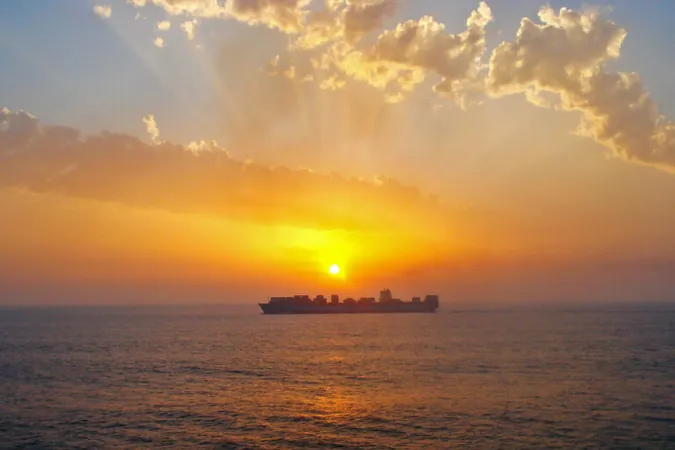
Shipping Emissions Cuts Trigger Unintended Global Warming: A Wake-Up Call for Climate Strategies
2024-11-13
Author: Wei Ling
Introduction
In recent years, a troubling phenomenon has surfaced in the North Atlantic Ocean, where sea surface temperatures have soared to unprecedented levels. This regional shift, which began escalating around mid-2023, has raised urgent questions about our changing climate and the role of human activities in accelerating these changes.
Historical Context
Historically, the North Atlantic warmed at a slower rate compared to other global regions. However, a rapid increase in temperatures has triggered destructive coral bleaching in the Caribbean and intensified storm activity across Europe and the U.S., including powerful hurricanes like Helene and Milton. Scientifically, this spike in heat is closely linked to the emissions of greenhouse gases, but a surprising twist has emerged: a significant change in shipping regulations.
Impact of Shipping Regulations
The reduction of sulfur dioxide emissions from shipping has inadvertently peeled back a cooling effect that may have masked a considerable portion of global warming. Sulfur emissions from commercial vessels, which accounted for around 13% of global sulfur dioxide emissions, produced sulfate aerosols essential for cloud formation. These aerosols created reflective marine clouds, known as "ship tracks," which helped cool the Earth's climate by bouncing solar radiation back into space, especially in areas with heavy shipping traffic.
The IMO Regulation
A recent International Maritime Organization (IMO) regulation enforced an 80% cut in allowable sulfur emissions from ship fuel. Following its implementation in January 2020, scientists reported a 25% drop in the number of observed ship tracks globally. Less marine cloud cover means more sunlight reaches the ocean's surface, causing an increase in ocean temperatures.
Consequences of Reduced Sulfur Emissions
Researchers estimate that these sulfur dioxide reductions are responsible for about 10-20% of the enhanced warming observed in the Northern Hemisphere over the past two years. This is particularly concerning given the concentration of shipping lanes in this region, exacerbating the warming effect. The aftermath has been a stark and alarming rise in unprecedented marine heatwaves along the busiest shipping routes, adding urgency to the climate crisis narrative.
Unintended Geoengineering Experiment
The recent shifts highlight the complexity of how human actions can unwittingly alter climatic systems. While reductions in aerosol emissions can help improve air quality and human health, they simultaneously reveal the harsh reality of climate feedbacks where the benefits of such regulations must be weighed against their unintended consequences.
Marine Cloud Brightening (MCB)
Interestingly, the abrupt reduction in aerosol emissions has served as an unintentional geoengineering experiment, spotlighting a controversial approach called marine cloud brightening (MCB). This technique proposes to enhance cloud reflectivity by spraying aerosols into the lower atmosphere to help cool the planet. However, this experiment's results raise pressing questions regarding the effectiveness and potential risks of scaling up MCB initiatives.
Risks of Large-scale MCB Implementation
Experts concur that any large-scale implementation of cloud brightening would require precise management to avoid significant regional disparities in cooling effects. The risk of generating unintended weather impacts, particularly in vulnerable regions, could pose severe ecological and social challenges.
Future Predictions and Policy Recommendations
With predictions indicating possible increases in global temperature by 0.05 to 0.1°C by 2030 linked to shipping emissions reductions, the evident fallout of these actions is a wake-up call for policies aimed at addressing climate change. Climate experts emphasize the necessity of synchronizing air pollution cuts with a robust strategy to reduce greenhouse gases, ensuring multiple environmental targets are met without sacrificing one for the other.
Conclusion
In conclusion, while the measures to mitigate harmful emissions from the shipping industry are commendable for improving public health, they also uncover unforeseen complexities in our global climate systems. As the world takes action to reduce carbon footprints, it must remain vigilant about the interplay between air pollution, climate change, and the potential for unintended consequences. The dialogue around geoengineering responses, such as marine cloud brightening, will be crucial as we navigate this intricate challenge moving forward.



 Brasil (PT)
Brasil (PT)
 Canada (EN)
Canada (EN)
 Chile (ES)
Chile (ES)
 España (ES)
España (ES)
 France (FR)
France (FR)
 Hong Kong (EN)
Hong Kong (EN)
 Italia (IT)
Italia (IT)
 日本 (JA)
日本 (JA)
 Magyarország (HU)
Magyarország (HU)
 Norge (NO)
Norge (NO)
 Polska (PL)
Polska (PL)
 Schweiz (DE)
Schweiz (DE)
 Singapore (EN)
Singapore (EN)
 Sverige (SV)
Sverige (SV)
 Suomi (FI)
Suomi (FI)
 Türkiye (TR)
Türkiye (TR)